UNIT 4.PROPAGATION OF MECHANICAL WAVES
Key unit competence: By the end of the unit I should be able to
evaluate the propagation of mechanical waves.
Unit Objectives:
By the end of this unit I will be able to;
◊ Explain the terms, concept and characteristics of waves properly.
◊ Explain the properties of waves.
◊ Explain the behavior of waves in vibrating strings and applicationsof waves properly.
Introductory Activity
a. Arrange yourselves the form of a circle with your right
shoulders pointing towards the centre.
b. Ask your friend to raise arms and then lower them. Then the
next friend raises arms and lowers them, and so on around the
circle. It should be like the “wave”.
c. Describe the type of the disturbance formed.
d. Is the disturbance travelling up and down or horizontally
around the circle?
e. Let one of your friend gently push the back of the next student
and then the pushed member should gently push the next
member and so on, which will make a wave travel around the ring.
f. From what you have done, can you describe what a disturbance
is? Is the disturbance travelling up and down or around the ring?
4.0 INTRODUCTION
When we think of the word “wave”, we usually visualize someone moving
his hand back and forth to say ‘hello’ or maybe we think of a tall curling
wall of water moving in from the ocean to crash on the beach.
In physics, a wave is a disturbance that occurs in a material medium and
in such process, energy is transferred from one place to another. When
studying waves, it’s important to remember that they transfer energy, not matter.
There are lots of waves all around us in everyday life. Sound is a type of
wave that moves through matter and then vibrates our eardrums and we
hear. Light is a special kind of wave that is made up of photons that helps us
to see. You can drop a rock into a pond and see wave formation in the water.
We even use waves (microwaves) to cook our food really fast. Application ofthis concept is extensively used in telecommunication and music.
4.1 THE CONCEPT OF WAVES
Waves can be defined as a disturbance in a medium that transfers energy
from one place to another, although the medium itself does not travel.
The term wave is often intuitively understood as referring to a transport
of spatial disturbances that are generally not accompanied by a motion
of the medium occupying this space as a whole. In a wave, the energy of
a vibration is moving away from the source in the form of a disturbance
within the surrounding medium. Other properties, however, although
usually described in terms of origin, may be generalized to all waves. For
such reasons, wave theory represents a particular branch of physics that
is concerned with the properties of wave processes independently of their
physical origin.
4.2 TERMS USED AND CHARACTERISTICS OF WAVES
All waves are characterized by the following terms;
The Time period (T) of the wave is the time it takes for one wavelength of
the wave to pass a point in space or the time for one cycle to occur. It is also
defined as the time taken between two successive wave crests or trough. It
is measured in seconds (s).
The frequency (f) is the number of wavelengths that pass a point in
space per second. In another words, it can be defined as the number of
complete oscillations or vibrations per second. Its SI unit is hertz (Hz).Mathematically;
The wavelength
 is the horizontal distance in space between two nearest
is the horizontal distance in space between two nearest
points that are oscillating in phase (in step) or the spatial distance overwhich the wave makes one complete oscillation. Its SI unit is metre (m).
That is, wave speed = wavelength × frequency.
This is the relationship between wavelength, frequency and velocity.
Amplitude is defined as the maximum distance measured from equilibrium
position (mean position). The amplitude is always taken as positive and is
measured in metres.
Phase difference (phase angle) is the angular difference between two
points on the wave or between two waves. Consider, two points O and P on
the wave as shown in Fig. 4-12.Phase difference is a whole number and is calculated using simple proportions;
The wave number, also called the propagation number k, is the spatial
frequency of a wave, either in cycles per unit distance or radians per unit
distance. It can be envisaged as the number of waves that exist over a
specified distance (analogous to frequency being the number of cycles orradians per unit time). Its unit is per metre (m–1). Mathematically;
The Intensity (I) of a wave or the power radiated by a source are proportional
to the square of the amplitude (x).
I ∝ x2
Wavefront is a line or surface in the path of the wave motion on which the
disturbance at every point have the same phase. This can also be defined
as the surface which touches all the wavelets from the secondary sources ofwaves. Consider the Huygens construction principle for the new wavefront.
Crest is the highest point above the equilibrium position while trough is
the lowest point below then equilibrium position.
The angular frequency ω represents the frequency in radians per second. Itis related to the frequency by
A node is a point half way between the crest and the trough. The line that
connects the nodes is the nodal line. The nodal line shows the originalposition of the matter carrying the wave.
Application Activity 4.1
1. Requirements: a manila paper with the drawing of the waveshown below
a) How do you call the distance represented by arrow z?
b) What letter is labelling the wave’s trough?
c) What letter is labelling a wave’s crest?
d) The number of waves that pass the poster per second is called
the …………….. of the waves.
e) If the knot (w) travels 2 meters in 1 second, we say that it has …………
….. of 2 m/s.
f) If the wavelengths were shortened, would the frequency be higher
or lower?
g) The greatest distance the knot (w) travels from its resting position
is called…………….. of the wave.h) What kind of wave are these in the rope?
2. Use the following descriptions in waves ad fill in the crosswordpuzzle bellow:
Across
1. How fast something is moving or how much distance is covered
in a certain amount of time.
3. The time it takes for a wave to repeat itself
4. The lowest point of a wave beneath the line of origin
9. Waves that require a medium
10. The highest point of a wave above the line of origin
11. Particles of light
12. A push or a pull
13. The tendency of an object at rest to remain at rest or in motion
until acted upon
Down
1. Waves that do not require a medium
2. The bouncing back of a wave when it meets the surface or boundary
3. The matter through which a wave travels
4. Distance in a given direction5. The vertical distance between the line of origin and the crest of a wave
4.3 TYPES OF WAVES
Waves are of three main types: Mechanical wave, electromagnetic wave
and matter wave.
These waves are classified based on conditions necessary for the wave to
propagate
4.3.1 Mechanical waves
These waves are produced by the disturbance in a material medium and
they are transferred by particles of the medium.
The matter through which mechanical waves travel is called the medium.
All mechanical waves require (1) some source of disturbance, (2) a medium
that can be disturbed, and (3) some physical mechanism through which
elements of the medium can influence each other.
Mechanical Waves are divided into two types according to the direction
of the displacements in relation to the direction of the motion of the wave
itself (wave form):
a) Longitudinal waves
When a wave propagates through some medium and the local displacements
of the medium that constitute the disturbance are in the direction of travel
of the disturbance, then the wave is longitudinal.
An example of a longitudinal wave is the pulse that can be sent along a
stretched slinky by shaking one end of the slinky along its length. The pulse
moves along the line of the slinky and ultimately makes the other end move.
Notice that in this case, the individual coils of the slinky vibrate back and
forth about some equilibrium position, but there is no net movement of theslinky itself.
b) Transverse waves
These are waves in which the direction of disturbance is perpendicular to
the direction of travel of the wave. The particles do not move along with the
wave; they simply oscillate up and down about their individual equilibriumpositions as the wave passes by.
4.3.1.4 Examples of mechanical waves
Mechanical waves, being progressive and stationary, are seen in different
forms as described in this section.
Sound waves
Sound waves are longitudinal waves. Sound waves travel fastest in solids,
slower in liquids and slowest in gases. This means the air particles (or
particles of the medium) move back and forth on paths that are parallel to
the direction of wave propagation and thus take the form of compressionsand rarefactions of the molecules in the air itself.
Water waves
Water waves are a combination of both transverse and longitudinal waves.
These waves are periodic disturbances that move away from the source andcarry energy as they go.
Ocean waves
These waves are longitudinal waves that are observed moving through the
bulk of liquids, such as our oceans. Ocean waves are powerful forces that
erode and shape of the world’s coastlines. Most of them are created by the
wind. Winds that blow over the top of the ocean, create friction between
the air and water molecules, resulting in a frictional drag as waves on thesurface of the ocean.
Earthquake waves
Earthquakes occur when elastic energy is accumulated slowly within the
Earth’s crust (as a result of plate motions) and then released suddenly
along fractures in the crust called faults. Earthquake waves are also called
seismic waves and actually travel as both transverse and longitudinal waves.
The P waves (Primary waves or compressional waves) in an earthquake
are examples of longitudinal waves. The P waves travel with the fastestvelocity and are the first to arrive.
The S waves (Secondary waves or shear waves) in an earthquake are
examples of transverse waves. S waves propagate with a velocity slowerthan P waves, arriving several seconds later.
Body Waves
Body waves are of two types: compressional or primary (P) waves which
are longitudinal in nature and shear or secondary (S) waves which are
transverse in nature. P- and S- waves are called ‘body waves’ because they
can travel through the interior of a body, such as the Earth’s inner layers,
from the focus of an earthquake to distant points on the surface. The Earth’s
molten core are only travelled by compressional waves.
Surface Waves
When waves occur at or near the boundary between two media, a transverse
wave and a longitudinal wave can combine to form a surface wave.
Examples of surface waves are a type of seismic wave formed as a result ofan earthquake and water waves.
4.3.2 Electromagnetic waves
These waves consist of disturbances in the form of varying electric and
magnetic fields. No material medium is necessary for their movement andthey travel more easily in vacuum than in matter.
Examples of electromagnetic waves are: Radio waves, Microwaves, Infrared
radiation, Visible light, Ultraviolet light, X-rays and Gamma rays. Thesewaves vary according to their wavelengths.
4.3.3 Matter Waves
If we perform the double slit diffraction experiment using a beam of electrons instead of light,
we still get a diffraction pattern. The interpretation
of this is that matter travels as a wave. Thus “matter acts as both a
particle and as a wave.” If we can sometimes consider an electron to be a wave,
what is its wavelength? Louis de Broglie postulated that all particles withmomentum have a wavelength
The matter waves describe the wavelike characteristics of atomic-level
particles.
For mechanical waves, the speed of the wave is a property of the medium,
speed does not depend on the size or shape of the wave.
Example 4.11. Find de Broglie wavelength for
4.4 PROGRESSIVE WAVES
A progressive wave is also called a travelling wave which consists of
a disturbance moving from one point to another. As a result, energy
is transferred between points. Progressive mechanical waves can be
categorised according to the direction of the effect of the disturbance relative
to the direction of travel.
Equation of a progressive wave
An equation can performed to represent displacement
of a vibrating particle in a medium in which a wave passes. Suppose a wave moves from
particle in a medium in which a wave passes. Suppose a wave moves from
left to right and that a particle at the origin moves with displacement givenby equation.

A particle at P will be out of phase from the particle at O, so, its displacement is given by;


EXAMPLE 1
A travelling wave is described by the equation y(x, t) = 0.003 cos (20x + 200t)
where y and x are measured in metres and t in seconds. What is the direction
in which the wave is travelling? Calculate the following physical quantities:
(a) angular wave number
(b) wavelength
(c) angular frequency
(d) frequency
(e) time period
(f) wave speed
(g) amplitude
particle velocity when x = 0.3 m and t = 0.02 s
(i) particle acceleration when x = 0.3 m and t = 0.02 s

4.5 PRINCIPLE OF SUPERPOSITION
The displacement at any time due to any number of waves meeting
simultaneously at a point in a medium is the vector sum of the individual
displacements of each one of the waves at that point at the same time.
This means that when two waves travel in a medium, their combined effect
at any point can be determined using this principle. Consider two waves of
displacements y1 and y2
passing through the same medium. The resultant displacement after superposition is:
When two pulses of equal or different amplitudes on a string approach each
other, then on meeting, they superimpose to produce a resultant pulse of
amplitude greater than any of the two. After crossing, the two pulses travel
independently.
4.5.1 Stationary waves
A stationary wave (or a standing wave) is a wave which results when
two waves travelling in opposite directions and having the same speed,
frequency and approximately equal amplitudes are superposed. A standingwave is shown in Fig. 4.6 below.


4.5.2 Mathematical treatment of superposition
Position of nodesA node is defined as the point of zero amplitude. This means
Equation (4.21) means that nodes are obtained when the horizontal
displacement of waves are odd quarter values of wavelength.
Position of antinodes
Antinodes are points of maximum displacements. So, antinodes are obtainedwhen the value of Equation 4.19 is maximum. This occurs when;


4.6 PROPERTIES OF WAVES
This section introduces the properties of waves and wave motion to describethe behaviour of waves in detail.
4.6.1 Reflection
This is the property of waves to bounce back from the surface on which they
hit. Huygens principle can also be applied to reflection. Consider a parallel
beam of light incident on the reflecting surface such that its direction oftravel makes an angle i with the normal to the surface.
Consider that side A of an associated wavefront AB has just reached the
surface. In the time that light from side B of the wavefront travels to B′, a
secondary wavelet of radius equal to BB′ will be generated by A. Because
of the reflecting surface, this wavelet is a semicircle above the surface. The
new wavefront generated by reflection will be the tangent to this waveletand will also contain point B′. The reflected wavefront will be A′B′.
We conclude by saying that all laws of reflection are obeyed. So, any
wavefront can reflect.
4.6.2 Refraction
Consider a parallel beam of waves (for example light waves) incident ona refracting surface between two media such that its direction of travel

At the same time, wavelets from A travel distance AD in medium 2. Here, a
refracted wavefront CD is formed by many wavelets in the beam. Fig.4-16above illustrates this description.
Equation 4-32 confirms Snell’s law meaning that waves behave like normal
light during reflection.
4.6.3 Interference
In the region where wave trains from coherent sources (sources of the same
frequency) cross, superposition occurs giving reinforcements of waves at
some points which is called constructive interference and cancellation at
others which is called destructive interference. The resulting effect is calledinterference pattern or the system of fringes.
4.6.4 Diffraction
This is a phenomenon in which waves from one source meet an obstacle
and spread around it. Diffraction is normally observed when these waves
pass through narrow slits. There are two types of diffraction and these are;
Fresnel’s diffraction and Fraunhofer diffraction.
a) Fresnel’s diffraction
This is a type of diffraction in which either the source of waves or screen
on which diffraction is observed or both are at finite distances from the
obstacle that cause diffraction. Below are different cases to explain thisdiffraction.
Case 1: the source and the screen placed at finite distances.
Case 2: the source is placed at infinite distance from obstacle and the screen is near.
Case 3: the screen is placed at infinite distance from obstacle and the source is near.

b) Fraunhofer Diffraction
This is a type of diffraction in which the source of waves and the screen
on which diffraction is observed are effectively at infinite distances from
the obstacle. This phenomenon is practically complicated but theoretically
understood. To obtain waves to or from infinite source in laboratory,biconvex lenses are used.
4.7 WAVE ON A VIBRATING STRING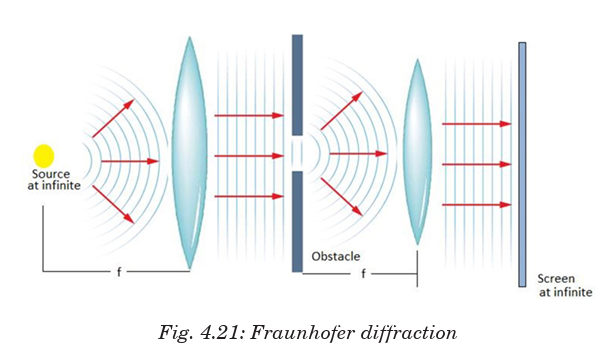
ACTIVITY 4-1: Propagation of Waves
Learning Objectives
• To observe the propagation of vibrations through a solid
• To understand how sound is transmitted through a medium
Required Materials
Spoon, string of length 1 m
Procedure
(a) Tie the spoon into the middle of the length of string so that it will hang
freely when you hold the string ends.
(b) Hold the string ends to your temples or the bone just under your earsas you strike the spoon with a pen or other object.
Discussion Questions
1. What causes the sound to be loud when the string is held to your head?
2. Why does the bone in front of your ear transmit vibrations more easily
than other bones?
3. What is the purpose of the string in this activity?
Standing wave also known as a stationary wave, is wave pattern that
results when two waves of the same frequency; wavelength and amplitude
travel in opposite directions along string and interfere.
The point at which the two waves cancel are called node. There no motion in
the string at the nodes, but midway between two adjacent nodes, the string
vibrates with the largest amplitude. These points are called antinodes. Atpoints between successive nodes the vibrations are in phase.
A single loop corresponds to either a crest or tough alone, while two loops
correspond to a crest and trough together, or one wave length.
Stationary waves are present in the vibrating strings of musical instruments.
A violin string, for instance, when bowed or plucked, vibrates as a whole,
with nodes at the ends, and also vibrates in halves, with a node at the center,
in thirds, with two equally spaced nodes, and in various other fractions, all
simultaneously. The vibration as a whole produces the fundamental tone,
and the other vibrations produce the various harmonics.
Standing waves can occur at more than one frequency. The lowest
frequency of oscillation that produces a standing wave gives rise to the
pattern shown in Fig. 4.24b. The standing waves shown in Figs. 4.24c and4.24d are produced at precisely twice and three times the lowest frequency,
respectively, assuming the tension in the cord is the same. The cord can also
oscillate with four loops (four antinodes) at four times the lowest frequency,
and so on.
The frequencies at which standing waves are produced are the natural
frequencies or resonant frequencies of the cord, and the different
standing wave patterns shown in Fig. 4.24 are different “resonant modes
of vibration.” A standing wave on a cord is the result of the interference of
two waves traveling in opposite directions. A standing wave can also be
considered a vibrating object at resonance. Standing waves represent the
same phenomenon as the resonance of an oscillating spring or pendulum,
However, a spring or pendulum has only one resonant frequency, whereas
the cord has an infinite number of resonant frequencies, each of which is a
whole-number multiple of the lowest resonant frequency.
one antinode (or loop). And as can be seen in Fig. 4.24b, the whole length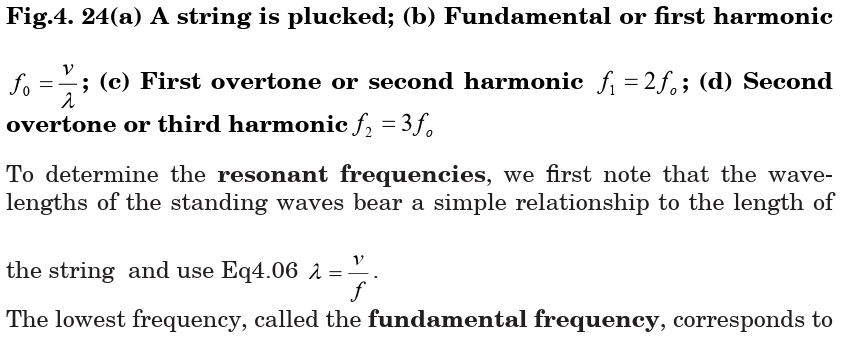
corresponds to one-half wavelength.
The other natural frequencies are called overtones; for a vibrating string
they are whole-number (integral) multiples of the fundamental, and then
are also called harmonics, with the fundamental being referred to as the
first harmonic. The next mode of vibration after the fundamental has two
loops and is called the second harmonic (or first overtone), Fig. 4.24c. The
length of the string at the second harmonic corresponds to one complete
A normal mode of an oscillating system is a motion in which all particles
of the system move sinusoidally with the same frequency
EXAMPLE 4
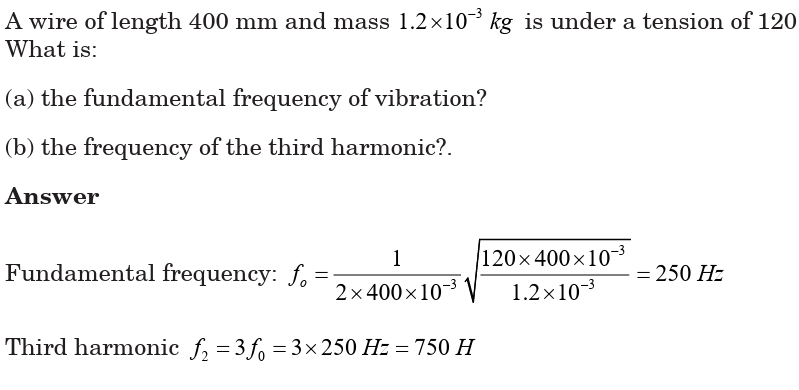
EXAMPLE 4
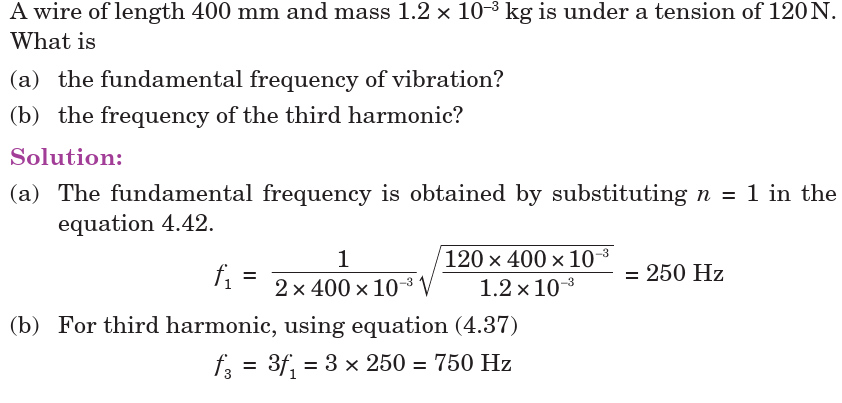
Application Activity 4.2
Use the following descriptions in waves and fill the puzzle
Down:
1) The part of a longitudinal wave where the particles of the medium
are close together.
2) A wave which needs to travel through a medium.
3) A repeated back-and-forth or up-and-down motion.
6) A wave which moves the medium in a direction across the direction.
the energy is traveling.
8) The ability to do work.
Across:
4) A disturbance that transfers energy from place to place.
5) The highest point of a wave.
7) The part of a longitudinal wave where the particles of the mediu
are far apart.
9) A wave which moves the medium in the same direction as the energy
is traveling.
10) The lowest part of a transverse wave.11) The material through which a wave travels.

END OF UNIT PROJECT
Materials to choose from:
3 white screens, 3 biconvex lenses, 3 biconcave lenses
, 3 biconvex
mirrors, 3 biconcave mirrors
, 3 boards with a hole, 3 laser pens, 3 big
torches, 3 very bright open lamps, 1 plane mirror.
The question:
Explain how you can perform Fresnel’s diffraction and Fraunhofer
diffraction in the laboratory.
Hypothesis:
Write a hypothesis about how diffraction is obtained in the lab.
Procedure
1. Decide which materials you will need (from the list) to test the hypothesis.
2. Plan your investigation.
a. Which arrangements best gives the idea of diffraction?
b. Which adjustments do you care to take care of ?
3. Write a procedure and show it to your teacher. Do not proceed
any further until it is approved.
4. Carry out your investigation.
Collecting Data
Make sure you have recorded at least the following information:
◊ the hypothesis
◊ your procedure
Analyzing and Interpreting
Share and compare your results with your classmates. Which idea is
important to be used and achieve the proper arrangement of apparatus to
achieve your objective?
Forming Conclusions
Make a brief report of your project with neat diagrams. In this project whatis needed is the concept not the analysis of the fringes formed.
END OF UNIT ASSESSMENT
1. The string shown in Figure below is driven at a frequency of 5.00 Hz.
The amplitude of the motion is 12.0 cm, and the wave speed is 20.0 m/s.
Determine the angular frequency and wave number k for this wave, andwrite an expression for the wave function.
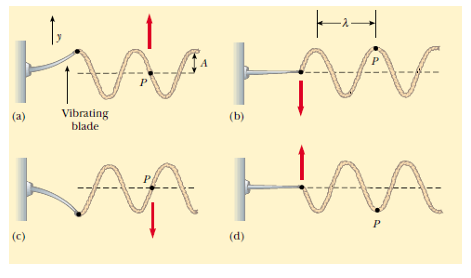
2. The wave shown in Fig. below is being sent out by a 60 Hz vibrator.
3. A string of length 3 m and mass density 0.0025 kg/m is fixed at both
ends. One of its resonance frequencies is 252 Hz. The next higher res
onance frequency is 336 Hz. Find the fundamental frequency and the
tension in the string.
4. A wire of length 400 mm and mass 1.2 *10-3 kg is under a tension of 120
N. What is
a) the fundamental frequency of vibration?
b) the frequency of the third harmonic?
5. A sinusoidal wave traveling in the positive x direction has an amplitude
of 15.0 cm, a wavelength of 40.0 cm, and a frequency of 8.00 Hz. The
vertical position of an element of the medium at t = 0 and x = 0 is also15.0 cm, as shown in Figure below.
(A) Find the wave number k, period T, angular frequency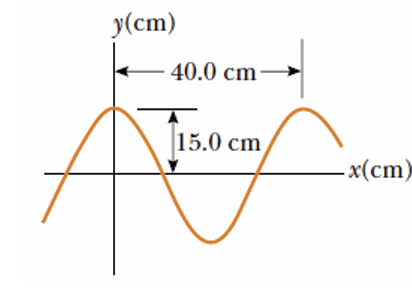
 and speed v of the wave.
and speed v of the wave.
(B) Determine the phase constant and write a general expression for the wave function.
and write a general expression for the wave function.
UNIT SUMMARY
Waves can be defined as a disturbance in a material medium that transfers
energy from one place to another.
The time period (T) of the wave is the time it takes for one complete
vibration of the wave.
The frequency f is the number of wavelengths that pass a point in space
in one second.
The wavelength is the horizontal distance in space between two nearest
is the horizontal distance in space between two nearest
points that are oscillating in phase.
The wave speed v is the speed at which the wave advances.
Phase difference (phase angle) is the angular difference between two
points on the wave or between two waves.
The wave number also called the propagation number k is the spatial
frequency of a wave.
The Intensity of a wave or the power radiated by a source are proportional
to the square of the amplitude.
Wavefront is a line or surface in the path of the wave motion on which the
disturbance at every point have the same phase.
Mechanical waves are waves produced by the disturbance in a material
medium.
A progressive wave consists of a disturbance moving from one point to
another.
Longitudinal wave propagates through some medium with vibrations in
the direction of propagation of the disturbance.
In Transverse waves, the direction of vibrations is perpendicular to the
direction of propagation of the wave.Equation of a progressive wave is given by:
Principle of superposition states that the resultant displacement at any
time is the vector sum of the individual displacements.Stationary waves are waves which seem to be at rest.
Electromagnetic waves are disturbances in form of varying electric and
magnetic fields.
All kinds of waves reflect, refract, interfere and also spread around the obstacle.
Other than the superposition of waves meeting at a point, other conditions
for interference are:
• The sources of the waves must be coherent, which means they emit
identical waves with a constant phase difference.
• The waves should be monochromatic - they should be of a singlewavelength.
